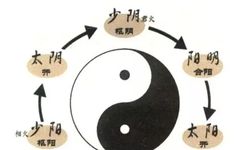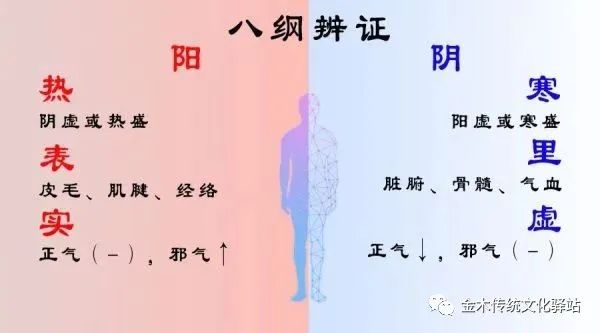
Yin, Yang, Exterior, Interior, Cold, Heat, Deficiency, and Excess are referred to as the “Eight Principles”.In clinical practice, the application of these eight principles for diagnosis is called “Eight Principles Diagnosis”. Although the symptoms of various diseases are complex, they can all be analyzed and summarized using the Eight Principles to explore the nature of the disease, the location of the pathological changes, the severity of the condition, and the strength of the individual’s response, thus providing a basis for clinical diagnosis and treatment.
Yin and Yang—-refer to the category of the disease, while Exterior and Interior indicate the depth of the pathological changes,Cold and Heat—-refer to the nature of the disease,Deficiency and Excess—-refer to the rise and fall of pathogenic and righteous Qi. Among these, Yin and Yang are the overarching principles that govern the other six principles (also known as the “Six Transformations”). Exterior, Heat, and Excess belong to Yang; Interior, Deficiency, and Cold belong to Yin. The four pairs of contradictions—Yin and Yang, Exterior and Interior, Cold and Heat, Deficiency and Excess—are relative and closely interconnected. For example, in Exterior syndrome, there are distinctions such as Exterior Cold, Exterior Heat, Exterior Deficiency, and Exterior Excess, as well as complex relationships like Exterior Cold with Interior Heat, Exterior Heat with Interior Cold, Exterior Deficiency with Interior Excess, and Exterior Excess with Interior Deficiency. The same applies to other Cold syndromes, Heat syndromes, Deficiency syndromes, and Excess syndromes. Under certain conditions, these four pairs of contradictions can transform into one another, such as from Exterior to Interior, from Interior to Exterior, Cold transforming into Heat, Heat transforming into Cold, from Yang to Yin, and from Yin to Yang, etc.
【1. Yin Syndrome】Weakness, lack of energy, cold limbs, pale complexion, no thirst, loose stools, clear urine. Tongue is pale with white coating, pulse is slow and thin, indicating a Yin syndrome.【2. Yang Syndrome】Excited spirit, red complexion, fear of heat, irritability, coarse breathing, high voice, thirst for cold drinks, short and yellow urine, difficult bowel movements, pulse is large, rapid, and strong, tongue is red with yellow coating, indicating a Yang syndrome.【1. Exterior Cold】Severe chills with mild fever, no sweating, body aches, limbs feel like ice, tongue coating is thin and white, pulse is floating and tight, Jing Fang Bai Du San is the most effective formula. 【2. Exterior Heat】Fever with aversion to wind, slight thirst, tongue edges are red, pulse is floating and rapid, Yin Qiao San is the main formula, using warm and cooling herbs to release the exterior. 【3. Exterior Deficiency】Fever with spontaneous sweating or aversion to wind, pulse is floating and weak, tongue is not red, Gui Zhi Tang is good for adjusting Ying and Wei, if the exterior is deficient, the symptoms must be relieved. 【4. Exterior Excess】Body aches with aversion to cold, no sweating, exterior excess syndrome must be detailed, pulse is floating and tight, tongue coating is thin and white, Ma Huang Tang is used to release the exterior with warm herbs. 【1. Interior Cold】Cold limbs, clear long urine, pale complexion, loose stools, pulse is often deep and slow, tongue is pale and white, Fu Zi Li Zhong Tang supports Yang. 【2. Interior Heat】Body heat, irritability, incoherent speech, thirst for cold drinks, yellow coating, dry stools, pulse is rapid and strong, Qing Re Bai Hu Tang is the best. 【3. Interior Deficiency】Shortness of breath, laziness to speak, palpitations, dizziness, cold limbs, pulse is thin and weak, tongue is pale, Ba Zhen Tang is used to tonify deficiency. 【4. Interior Excess】Irritability, incoherent speech, coarse breathing, abdominal fullness, constipation, yellow tongue coating, sweating of hands and feet, pulse is deep and strong, Xiao Feng San is used to clear heat and drain fire.
【Common Treatment Methods】Over the years, TCM has accumulated a wealth of treatment methods, and with the development of the times, new treatment methods have been continuously innovated. Here are some of the most commonly used methods in TCM: Sweating method, Clearing method, Downward method, Harmonizing method, Warming method, Tonifying method, Reducing method, Regulating Qi method, Regulating Blood method, Expelling Heat method, and Expelling Phlegm method.
【1. Sweating Method】For initial exterior syndrome, the sweating method is most appropriate, with exterior cold and exterior heat, using warm and cool herbs. For exterior cold, use Gui Zhi, Qiang Huo, Fang Feng, and for exterior heat, use Yin Qiao, Bo He, and Mu Dan Pi. The specific application depends on the patient’s condition. 【2. Clearing Method】For intense heat, the clearing method should be used, especially for Qi and Ying deficiency with heat. Bai Hu Tang clears heat from the Qi level, Qing Ying Tang treats heat in the Ying level. For heat in the blood, use Xi Jiao Di Huang Tang, Long Dan Cao for liver fire, and for deficiency heat, use Qing Hao Bie Jia Tang. 【3. Downward Method】For interior excess, the downward method is necessary, with cold and warm herbs used differently. Da Cheng Qi Tang is a cold purgative, while Wen Pi Tang is commonly used for warming. Shi Zao Tang is used for urgent cases of excess water in the abdomen. 【4. Harmonizing Method】For half exterior and half interior, the harmonizing method is appropriate, especially for Shaoyang liver and gallbladder, spleen and stomach. For alternating cold and heat, Xiao Chai Hu Tang is effective. For gallbladder Qi invading the stomach, use Hao Ling Qing Dan, and for liver Qi stagnation, use Xiao Yao San. 【5. Warming Method】For cold evil invading or internal generation, the warming method is different. For spleen and stomach deficiency cold with abdominal pain and diarrhea, use Li Zhong Wan. For excess cold with Yang deficiency, use Si Ni San. 【6. Tonifying Method】For weakness and fatigue, tonifying methods are used to replenish Qi and blood. For Qi deficiency, use Si Jun Zi Tang, and for blood deficiency, use Si Wu Tang. For Yin deficiency, use Liu Wei Di Huang Wan, and for Yang deficiency, use Jin Gui Shen Qi Wan. 【7. Reducing Method】For masses and stagnation, the reducing method is used to dissolve and guide stagnation. For Qi and blood stagnation, use Er Chen Tang and San Leng. For ectopic pregnancy with severe abdominal pain, use Huo Luo Xiao Ling Dan. 【8. Regulating Qi Method】For Qi stagnation, the regulating Qi method is used. For Qi stagnation in the chest and abdomen, use Chai Hu Shu Gan San. For Qi counterflow, use Su Zi Jiang Qi Tang. 【9. Regulating Blood Method】For blood stagnation, the regulating blood method is used. For blood stasis due to trauma or menstrual disorders, use Tao Ren Cheng Qi Tang. 【10. Expelling Heat Method】For damp-heat, the expelling heat method is used. For damp-heat in the lower jiao, use San Ren Tang. 【11. Expelling Phlegm Method】For phlegm-dampness, the expelling phlegm method is used. For phlegm obstructing the lungs, use Er Chen Tang.
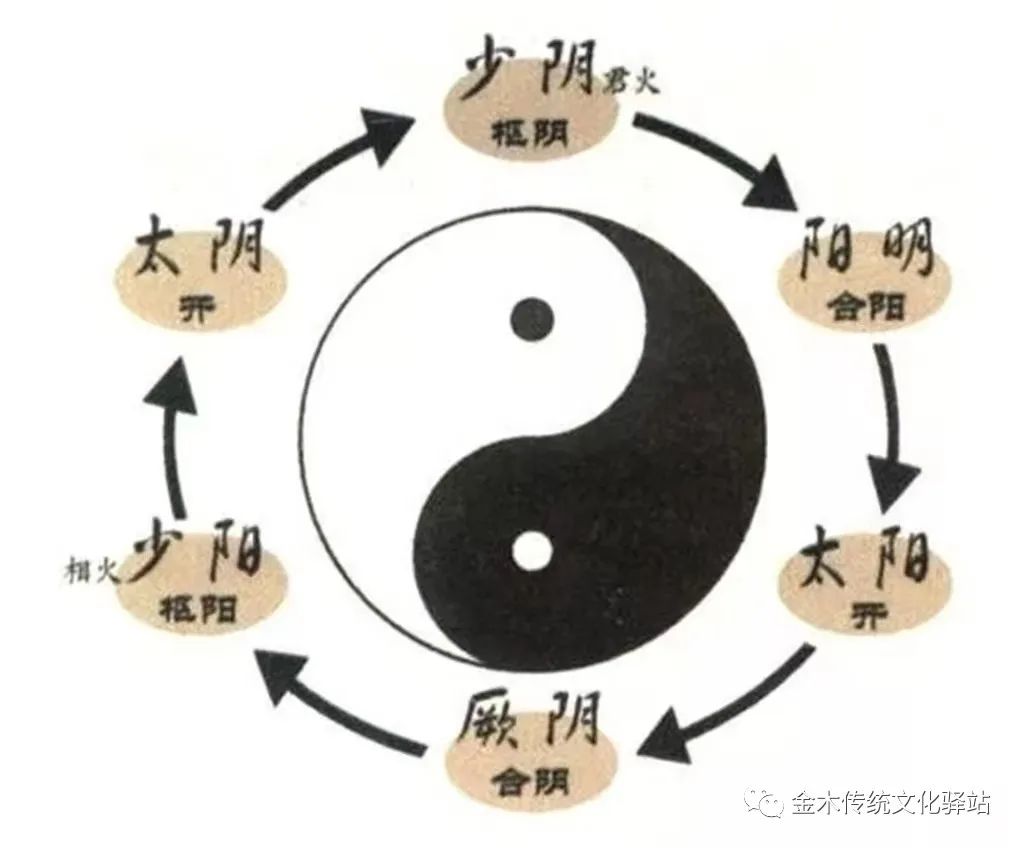
【TCM Six Meridians Diagnosis Method】The Six Meridians Diagnosis is a method summarized by the famous physician Zhang Zhongjing of the Eastern Han Dynasty based on the general rules of the occurrence and development of exogenous febrile diseases. For thousands of years, it has effectively guided the diagnosis and treatment in TCM. The Six Meridians Diagnosis divides the clinical manifestations during the development of exogenous febrile diseases into six syndromes: Taiyang, Yangming, Shaoyang, Taiyin, Shaoyin, and Jueyin, based on Yin and Yang. The Six Meridians reflect the pathological changes of the organs, meridians, Qi, and blood.
The Six Meridians Diagnosis analyzes, compares, summarizes, and synthesizes the complex clinical manifestations based on the strength of the body’s righteous Qi, the nature of the pathogenic factors, and the progression of the disease, thus determining the location, nature, and pathogenesis of the disease, providing a basis for treatment. The Six Meridians Diagnosis is applicable not only to exogenous febrile diseases but also to the diagnosis and treatment of internal injuries and miscellaneous diseases.
【First Section: Taiyang Disease】
【1. Wind Stroke】Wind evil injures the defensive Qi, causing disharmony between Ying and Wei, with sweating, aversion to wind, and floating pulse. Gui Zhi Tang is effective. 【2. Cold Damage】Cold damage injures Yang, causing fever, headache, and aversion to cold, with no sweating and tight pulse. Ma Huang Tang is used to release the exterior. 【3. Water Accumulation】If the exterior evil is not resolved, it can lead to bladder issues, with fever, sweating, and thirst. Wu Ling San is commonly used. 【4. Blood Accumulation】Evil heat and blood stagnation in the lower jiao, with urgent and hard fullness in the lower abdomen. Tao Ren Cheng Qi Tang is used to resolve blood heat.
【Second Section: Yangming Disease】
【1. Channel Syndrome】Intangible heat in the Yangming channel, with thirst, irritability, and yellow tongue coating. Bai Hu Tang is used to clear heat and generate fluids. 【2. Organ Syndrome】Tangible heat stagnation in the organs, with fullness and dryness. Da Cheng Qi Tang is used to purge heat. 【3. Warm Heat with Jaundice】Damp-heat causing yellowing of the skin, with fever and thirst. Yin Chen Hao Tang is the main formula.
【Third Section: Shaoyang Disease】
Alternating cold and heat, with dizziness, bitter taste, and dry throat. Xiao Chai Hu Tang is effective.
【Fourth Section: Taiyin Disease】Taiyin syndrome is related to spleen and stomach cold, with abdominal fullness, pain, diarrhea, and preference for warmth. Li Zhong Wan is used to warm the middle and dispel cold.
【Fifth Section: Shaoyin Disease】【1. Cold Transformation】Yin cold internally, with heart and kidney failure, cold limbs, and weak pulse. Si Ni Tang is used to rescue Yang. 【2. Heat Transformation】Heart and kidney not communicating, leading to heat transformation, with thirst and insomnia. Huang Lian E Jiao Tang is used to nourish Yin.
【Sixth Section: Jueyin Disease】【1. Cold Jue】Yin excess and Yang deficiency, with cold limbs and no heat. Si Ni Tang is used to rescue Yang. 【2. Heat Jue】Heat evil obstructing Yang, with high fever and irritability. Qing Wei San is used to clear heat.
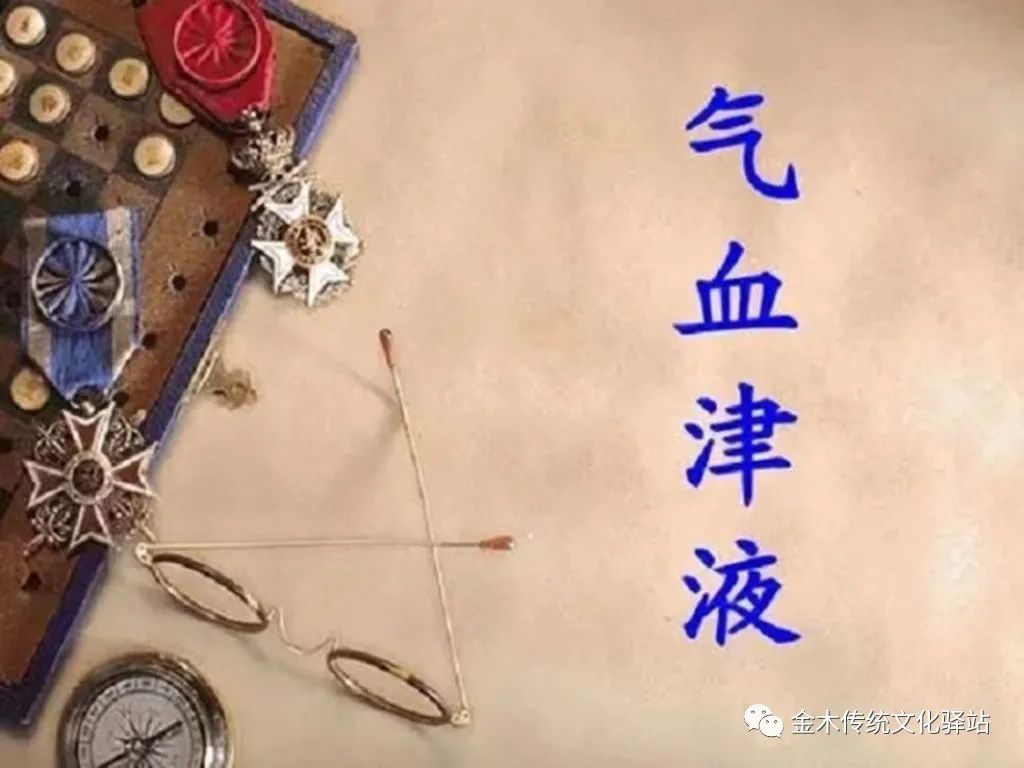
【Diagnosis of Qi, Blood, and Body Fluids in TCM】Qi, blood, and body fluids are products of the normal physiological activities of the organs, governed by the organs, and they are the material basis for life activities. Once Qi, blood, and body fluids undergo pathological changes, they not only affect the function of the organs but also impact the life activities of the body. Conversely, when the organs undergo pathological changes, it inevitably affects the changes in Qi, blood, and body fluids. The diagnosis of Qi, blood, and body fluids can be divided into Qi disease diagnosis, blood disease diagnosis, simultaneous Qi and blood disease, and body fluid disease diagnosis.
【First Section: Qi Disease】Original Qi is stored in the kidneys, and the essence of the kidneys generates the source of life, maintaining the function of the organs. The essence combines to form the fundamental Qi, distributed throughout the body. The righteous Qi is the original Qi that resists external evils, maintaining health and vitality. Qi disease is often seen as deficiency and stagnation, with symptoms such as spontaneous sweating, weak pulse, fatigue, and shortness of breath. The primary formula for Qi deficiency is Si Jun Zi Tang, with modifications based on clinical presentation. For Qi stagnation, use Chai Hu Shu Gan San and Su Zi Jiang Qi Tang for counterflow.
【Second Section: Blood Disease】Food essence produces blood, nourishing the body. Blood deficiency, stasis, and bleeding are the three major syndromes, each with different clinical manifestations. Blood deficiency presents with pale complexion, dizziness, and weak pulse. The primary formula for blood deficiency is Si Wu Tang. For blood stasis, use Tao Ren Cheng Qi Tang. For blood heat, use Tao Ren Cheng Qi Tang to clear heat and resolve stasis.
【Third Section: Simultaneous Qi and Blood Disease】Qi is Yang and blood is Yin; they depend on each other. Qi stagnation leads to blood stasis, with symptoms such as chest and abdominal pain. Use Tao Ren Cheng Qi Tang for blood stasis and Si Jun Zi Tang for Qi deficiency.
【Fourth Section: Body Fluid Disease】Diet produces body fluids, which nourish the tissues. Insufficient body fluids lead to symptoms such as dryness and thirst. Use Mai Men Dong and Sha Shen to nourish body fluids. For phlegm-dampness, use Er Chen Tang to resolve phlegm.
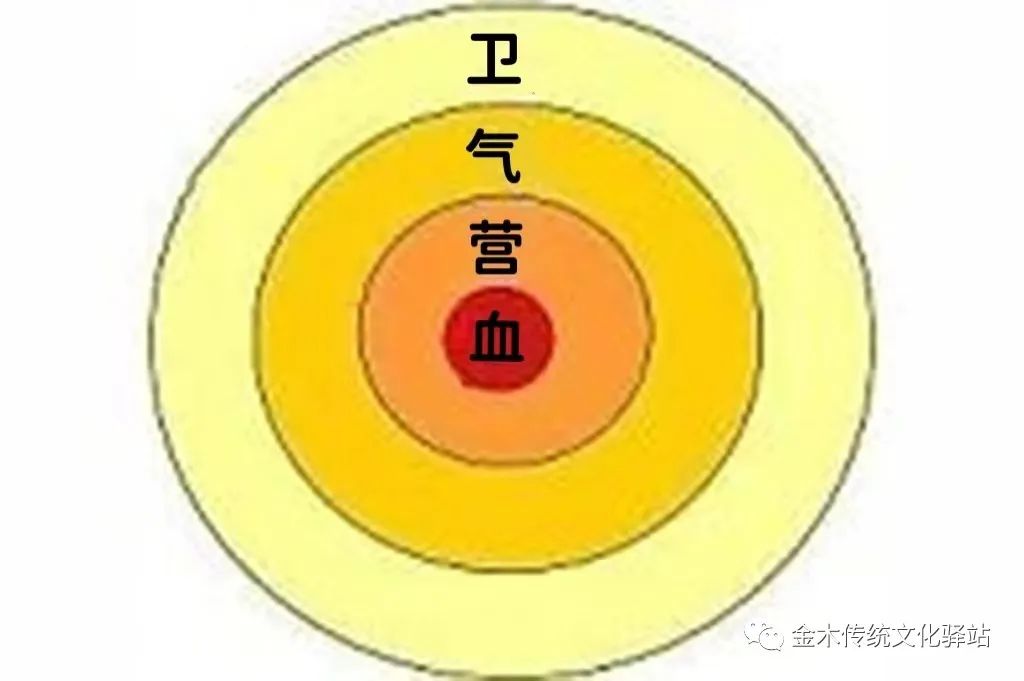
【Diagnosis of Wei, Qi, Ying, and Blood】This diagnosis method was developed by Qing Dynasty physician Ye Gui based on the general rules of the occurrence and development of exogenous warm diseases. It represents four different levels or stages of disease severity and location. The development of warm diseases generally follows the stages of Wei, Qi, Ying, and Blood. If the disease is in the Wei or Qi level, it is considered superficial; if it is in the Ying or Blood level, it is considered deep. In the early stages of acute febrile diseases, the Wei level is often involved, with mild fever and thirst. For Qi level heat, use Bai Hu Tang to clear heat. If the disease enters the Ying level, it may lead to confusion and rash, requiring Qing Ying Tang to clear heat from the Ying level.
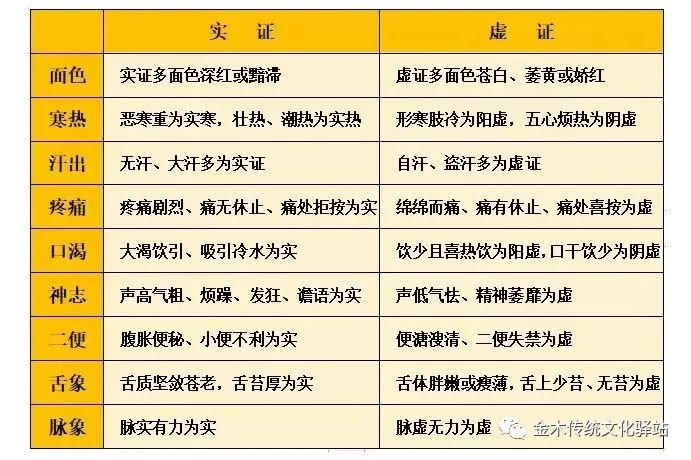
【Diagnosis of Six Evils】The diagnosis of the six evils refers to the diseases caused by the six external evils: wind, cold, heat, dampness, dryness, and fire. The occurrence of these diseases is often related to the seasons. For example, wind diseases are common in spring, heat diseases in summer, damp diseases in late summer, dry diseases in autumn, and cold diseases in winter. The six evils are not fixed and can manifest differently based on the individual’s constitution. For example, a person with a Yang constitution may experience heat from wind, while a person with a Yin constitution may experience cold. Therefore, it is essential to identify the representative symptoms of the six evils for clinical diagnosis.
【First Section: Wind】Wind evil invades without a trace, injuring the exterior and affecting the meridians. Symptoms include aversion to wind, sweating, fever, cough, and nasal congestion. Use Jing Fang Bai Du San to disperse wind and clear heat. 【2. Cold】Cold is a Yin evil that can injure Yang, causing symptoms such as aversion to cold, fever, and joint pain. Use Ma Huang Tang to disperse cold. 【3. Heat】Heat evil can easily injure body fluids, leading to symptoms such as fever, thirst, and irritability. Use Bai Hu Tang to clear heat and generate fluids. 【4. Dampness】Dampness can obstruct the body, leading to symptoms such as heaviness, fatigue, and digestive issues. Use Ping Wei San to resolve dampness.
【Diagnosis of Zang-Fu Organs】Diagnosis of the Zang-Fu organs involves understanding the functions and interrelations of the organs. For example, heart Qi deficiency may lead to palpitations and fatigue, while liver Qi stagnation may cause irritability and abdominal pain. Treatment should focus on tonifying the heart and regulating the liver. Use Gui Pi Tang for heart Qi deficiency and Xiao Yao San for liver Qi stagnation.
【Conclusion】In TCM, diagnosis and treatment are based on a comprehensive understanding of the patient’s condition, including the Eight Principles, Six Meridians, Qi, Blood, and Zang-Fu organs. By applying these principles, practitioners can develop effective treatment strategies tailored to the individual needs of each patient.

